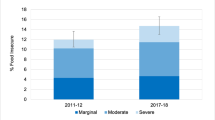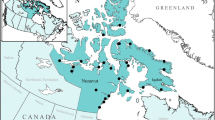Abstract
Objectives
To assess trends in food insecurity between 2005 and 2017—a period including the Great Recession—by participation in the Special Supplemental Nutrition Program for Women, Infants and Children (WIC).
Methods
Data from the California Health Interview Survey (CHIS), 2005–2017, were used, including 7421 households: WIC participants (n = 4184)—those participating in WIC only (n = 2315) and in the Supplemental Nutrition Assistance Program (SNAP) in addition to WIC (n = 1869)—and WIC-eligible non-participants (n = 3237). Multivariable logistic regression models were run with food insecurity as the outcome, WIC participation and survey year as predictors, and adjusted by children’s and family’s demographic and socioeconomic variables. Interactions between WIC participation and survey year were tested.
Results
WIC + SNAP participating households had higher crude food insecurity prevalence across time compared to WIC only and WIC-eligible non-participant households. In fully adjusted models: (1) food insecurity was higher between 2009 and 2017, compared to 2005, for all groups; (2) WIC participating households had higher odds of food insecurity than WIC-eligible non-participants (OR = 1.23, 95%CI = 1.10–1.38); (3) when WIC participants were split into WIC only and WIC + SNAP, WIC + SNAP households had higher odds of food insecurity than WIC-eligible non-participants (OR = 1.45, 95%CI = 1.27–1.66); and (4) the association between food insecurity and WIC participation did not change across time (interaction p-value > 0.10).
Conclusions
Food insecurity increased post-Great Recession among low-income households with children in California, with those participating in WIC, particularly in WIC + SNAP, at higher risk. WIC should consider additional referrals for households who participate in WIC + SNAP.
Significance
What is already known on this subject? Food insecurity prevalence spiked during the Great Recession for all U.S. households, including those participating in WIC and SNAP. In 2009, SNAP benefits were expanded, and the WIC food package change was updated.
What this study adds? Focusing on households with children who participated in WIC in California, this study found that food insecurity trends between 2005 and 2017 were not significantly different between WIC-eligible non-participant households and households who participated in WIC alone. On the other hand, households participating in WIC + SNAP had higher odds of food insecurity across time, when compared to WIC-eligible non-participant households.

Similar content being viewed by others
Data Availability
Data used in this paper are available via an application to CHIS’ Data Access Center.
Code Availability
SAS code used for this paper’s analyses is available upon request to the corresponding author.
References
Anderson, S. A. (1990). Core indicators of nutritional state for difficult-to-sample populations. The Journal of Nutrition,120(11S), 1557–1600.
Arteaga, I., Heflin, C., & Gable, S. (2016). The impact of aging out of WIC on food security in households with children. Children and Youth Services Review,69, 82–96.
Blumberg, S. J., Bialostosky, K., Hamilton, W. L., & Briefel, R. R. (1999). The effectiveness of a short form of the household food security scale. The American Journal of Public Health,89(8), 1231–1234.
Chaparro, M. P., Crespi, C., Anderson, C., Wang, M. C., & Whaley, S. E. (2019). The 2009 special supplemental nutrition program for women, infants, and children (WIC) food package change and children’s growth trajectories and obesity in Los Angeles County. American Journal of Clinical Nutrition,109, 1414–1421.
Cho, S. J. (2022). The effect of aging out of the women, infants, and children (WIC) program on food insecurity. Health Economics,31(4), 664–685.
Coleman-Jensen, A., Rabbitt, M. P., Gregory, C. A., & Singh, A. (2018). Household food security in the United States in 2017. U.S. Department of Agriculture, Economic Research Service. Economic Research Report Number 256, September 2018. Retrieved September 9, 2022, from https://www.ers.usda.gov/webdocs/publications/90023/err-256.pdf?v=0
Coleman-Jensen, A., Rabbitt, M. P., Gregory, C. A., Singh, A. (2021) Household food security in the United States in 2020. U.S. Department of Agriculture, Economic Research Service. Economic Research Report No. 298, September 2021. Retrieved September 9, 2022 from https://www.ers.usda.gov/webdocs/publications/102076/err-298.pdf?v=5710.1
Daepp, M. I. G., Gortmaker, S. L., Wang, Y. C., Long, M. W., & Kenney, E. L. (2019). WIC food package changes: Trends in childhood obesity prevalence. Pediatrics,143(5), e20182841.
de Cuba, S. E., Chilton, M., Bovell-Ammon, A., Knowles, M., Coleman, S. M., Black, M. M., Cook, J. T., Cutts, D. B., Casey, P. H., Heeren, T. C., & Frank, D. A. (2019). Loss of SNAP is associated with food insecurity and poor health in working families with young children. Health Affairs,38(5), 765–773.
Gundersen, C., Kreider, B., & Pepper, J. (2011). The economics of food insecurity in the United States. Applied Economic Perspectives and Policy,33(3), 281–303.
Gundersen, C., Kreider, B., & Pepper, J. V. (2017). Partial identification methods for evaluating food assistance programs: A case study of the causal impact of SNAP on food insecurity. American Journal of Agricultural Economics,99, 875–893.
Insolera, N., Cohen, A., & Wolfson, J. A. (2022). SNAP and WIC participation during childhood and food security in adulthood, 1984–2019. American Journal of Public Health,112, 1498–1506.
Jensen, H. H., Kreider, B., & Zhylyevskyy, O. (2019). Investigating treatment effects of participating jointly in SNAP and WIC when the treatment is validated only for SNAP. Southern Economic Journal,86, 124–155.
Kreider, B., Pepper, J. V., Gundersen, C., & Jolliffe, D. (2012). Identifying the effects of SNAP (Food stamps) on child health outcomes when participation is endogenous and misreported. Journal of the American Statistical Association,107(499), 958–975.
Kreider, B., Pepper, J. V., & Roy, M. (2016). Identifying the effects of WIC on food insecurity among infants and children. Southern Economic Journal,82, 1106–1122.
Mabli, J., & Ohls, J. (2015). Supplemental nutrition assistance program participation is associated with an increase in household food security in a national evaluation. The Journal of Nutrition,145(2), 344–351.
Metallinos-Katsaras, E., Gormahn, K. S., Wilde, P., & Kallio, J. (2011). A longitudinal study of WIC participation on household food insecurity. Maternal and Child Health Journal,15, 627–633.
Meyer, B. D., Mok, W. K. C., & Sullivan, J. X. (2009). The under-reporting of transfers in household surveys: Its nature and consequences. National Bureau of Economic Research, NBER Working Paper Series N. 15181. Retrieved September 14, 2022 from https://www.nber.org/system/files/working_papers/w15181/w15181.pdf
Nord, M., & Prell, M. (2011). Food security improved following the 2009 ARRA increase in SNAP benefits. U.S. Department of Agriculture, Economic Research Service, Economic Research Report No.116. Retrieved September 9, 2022, from https://www.ers.usda.gov/webdocs/publications/44837/7469_err116.pdf?v=1358.7
Ratcliffe, C., McKernan, S., & Zhang, S. (2011). How much does the supplemental nutrition assistance program reduce food insecurity? American Journal of Agricultural Economics,93, 1082–1098.
Schanzenbach, D. W., & Pitts, A. (2020). Estimates of food insecurity during the COVID-19 crisis: Results from the COVID Impact Survey, Week 1 (April 20–26, 2020). Institute for Policy Research Rapid Research Report. Retrieved September 9, 2022, from https://www.ipr.northwestern.edu/documents/reports/food-insecurity-covid_week1_report-13-may-2020.pdf
Schultz, D. J., Byker Shanks, C., & Houghtaling, B. (2015). The impact of the 2009 special supplemental nutrition program for women, infants, and children food package revisions on participants: A systematic review. Journal of the Academy of Nutrition and Dietetics,115(11), 1832–1846.
Taylor, J. (2006). Updating the WIC food packages: It’s about time. National Health Policy Forum, Issue Brief No. 816. George Washington University.
Tsai, M., Au, L., Ritchie, L., Anderson, C., Martinez, C., Whaley, S. (2022). Larger WIC cash value benefit for vegetables and fruit is associated with lower food insecurity and improved participant satisfaction in WIC families With children. Current Developments in Nutrition, 6(Suppl 1), 231.
The White House (2021). Fact Sheet: President Biden’s new executive actions deliver economic relief for American families and businesses amid the COVID-19 crises. Retrieved September 13, 2022, from https://www.whitehouse.gov/briefing-room/statements-releases/2021/01/22/fact-sheet-president-bidens-new-executive-actions-deliver-economic-relief-for-american-families-and-businesses-amid-the-covid-19-crises/
UCLA Center for Health Policy Research (2012). California Health Interview Survey. Retrieved September 9, 2022, from http://healthpolicy.ucla.edu/chis/Pages/default.aspx
U.S. Congress. (2009) H.R.1 - American Recovery and Reinvestment Act of 2009. Retrieved September 9, 2022 from https://www.congress.gov/bill/111th-congress/house-bill/1/text
U.S. Department of Agriculture (USDA), Economic Research Service. (2012) U.S. Household food security survey module: Six-item short form. Retrieved September 9, 2022 from https://www.ers.usda.gov/media/8282/short2012.pdf
U.S. Department of Agriculture (2021). USDA modernizes the Thrifty Food Plan, updates SNAP benefits. Retrieved September 14, 2022, from https://www.usda.gov/media/press-releases/2021/08/16/usda-modernizes-thrifty-food-plan-updates-snap-benefits .
U.S. Department of Agriculture (USDA), Economic Research Service (2022). Food security in the U.S. Interactive charts and highlights. Trends in U.S. food security. Retrieved September 13, 2022, from https://www.ers.usda.gov/topics/food-nutrition-assistance/food-security-in-the-u-s/interactive-charts-and-highlights/#trends
Waxman, E., Gundersen, C., & Thompson, M. (2018). How far do SNAP benefits fall short of covering the cost of a meal? Urban Institute. Retrieved September 13, 2022, from https://www.urban.org/sites/default/files/publication/96661/how_far_do_snap_benefits_fall_short_of_covering_the_cost_of_a_meal_6.pdf
Waxman, E., Gundersen, C., Fiol, O. (2021) The USDA's change to the Thrifty Food Plan will close the gap between SNAP benefits and meal costs for people living in most US counties. Urban Institute. Retrieved September 13, 2022 from https://www.urban.org/urban-wire/usdas-change-thrifty-food-plan-will-close-gap-between-snap-benefits-and-meal-costs-people-living-most-us-counties
Funding
This study was funded by the Tufts University/University of Connecticut Research Innovation and Development Grants in Economics (RIDGE) Program.
Author information
Authors and Affiliations
Contributions
MPC and MAL performed the research. MPC designed the research study. MPC and MAL analyzed the data. MPC wrote the paper. MAL edited the paper.
Corresponding author
Ethics declarations
Conflict of interest
The authors have not disclosed any competing interests.
Ethical Approval
The analyses for this study were conducted by staff at the California Health Interview Survey (CHIS) Data Access Center (DAC). The UCLA South General Institutional Review Board has approved the DAC to conduct analyses of confidential CHIS data (IRB#11-002227).
Consent to Participate
CHIS is a telephone survey. Before starting the survey questions, the CHIS interviewer reads a script to the respondent in which the interviewer introduces him/herself, UCLA, and the survey sponsors; explains the purpose of the survey as well as its voluntary and confidential nature; explains the respondent’s right to skip questions and/or terminate the survey at any time; and asks if the respondent wishes to participate. If the respondent agrees to participate in the survey, consent is implied.
Consent to Publication
Not Applicable.
Additional information
Publisher’s Note
Springer Nature remains neutral with regard to jurisdictional claims in published maps and institutional affiliations.
Rights and permissions
Springer Nature or its licensor (e.g. a society or other partner) holds exclusive rights to this article under a publishing agreement with the author(s) or other rightsholder(s); author self-archiving of the accepted manuscript version of this article is solely governed by the terms of such publishing agreement and applicable law.
About this article
Cite this article
Chaparro, M.P., Lopez, M.A. Trends in Food Insecurity Among Households with Children Participating in WIC and SNAP in California, 2005–2017. Matern Child Health J 28, 315–323 (2024). https://doi.org/10.1007/s10995-023-03829-8
Accepted:
Published:
Issue Date:
DOI: https://doi.org/10.1007/s10995-023-03829-8




